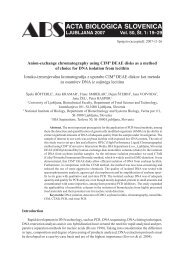ACTA BIOLOGICA SLOVENICA - ZRC SAZU
ACTA BIOLOGICA SLOVENICA - ZRC SAZU
ACTA BIOLOGICA SLOVENICA - ZRC SAZU
You also want an ePaper? Increase the reach of your titles
YUMPU automatically turns print PDFs into web optimized ePapers that Google loves.
38 Acta Biologica Slovenica, 52 (2), 2009<br />
Fig. 4: Whole cell of the diatom Coscinodiscus walesii, used to focus laser light, and details of the regular<br />
perforations in the frustrule that cause the diffractive bending of the light. The data on width of the perforations<br />
indicated in some places are printed in a font too small to be read here, but range 1.5 to 1.7 µm,<br />
and the distances between them 800-987 nm. From De st e fa n o l., i. re a, i. re n D i n a, M. De st e fa n o &<br />
l. Mo r e t t i 2007: Lensless light focusing with the centric marine diatom Coscinodiscus walesii. Optics<br />
Express 15: 18082–18088.<br />
Slika 4: Celotna celica kremenaste alge vrste Coscinodiscus walesii, uporabljena za fokusiranje laserskega žarka,<br />
in detajli luknjic v frustuli, ki povzročijo difrakcijo svetlobe. Podatki o širini luknjic, ki so na nekaterih<br />
mestih označeni so premajhni, da bi jih lahko prebrali. So v razponu od 1.5 do 1.7 µm, razdalje med<br />
njimi pa so od 800 do 987 nm. From De st e fa n o l., i. re a, i. re n D i n a, M. De st e fa n o & l. Mo r e t t i<br />
2007: Lensless light focusing with the centric marine diatom Coscinodiscus walesii. Optics Express 15:<br />
18082–18088.<br />
Diatoms are important also for their contents<br />
of omega-6 and omega-3 fatty acids, which reach<br />
us indirectly via fish in our diet. Both are essential<br />
for us, since they are needed for our brain and<br />
some other organs, and we cannot make them<br />
ourselves. The requirement of omega-6 acids is<br />
not very great, and too much inhibits the uptake<br />
in the brain cells of the omega-3 acids (Novak et<br />
al. 2008). Work is now in progress to circumvent<br />
the fish route and get the acids more directly into<br />
human diet, and at the same time to optimize<br />
References<br />
the omega-6/omega-3 ratio. The fats of diatoms<br />
have also been considered as biofuels for motor<br />
vehicles.<br />
Acknowledgement<br />
The authors stand in great debt to Professor<br />
Helen Ghiradella for her improvements of our<br />
original manuscript.<br />
alv e r s o n A.J. 2007: Strong purifying selection in the silicon transporters of marine and freshwater<br />
diatoms. Limnol. Oceanogr. 52: 1420–1429.<br />
alv e r s o n A.J. 2008: Molecular systematics and the diatom species. Protist 159: 339–353.<br />
Be rt r a n D J. 2008: Diatom movements VIII: Synthesis and hypothesis. Diatom Res. 23: 19–29.<br />
Bl a C k B u r n M.v., f. Ha n n a H & a. ro g e r s o n 2009. First account of apochlorotic diatoms from mangrove<br />
waters in Florida. J. Eukaryot. Microbiol. – 56:194–200.<br />
Br z e z i n s k i M.A. 1992: Cell-cycle effects on the kinetics of silicic acid uptake and resource competition<br />
among diatoms. J. Plankton Res. 14: 1511–1539.<br />
Br z e z i n s k i M.A., R.J. Olson & S.W. Chisholm 1990: Silicon availability and cell-cycle progression<br />
in marine diatoms. Mar. Ecol. Prog. Ser. 67: 83–96.



